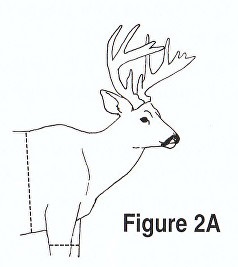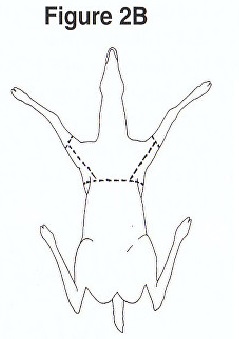Field Care for Shoulder Mounts:
With a sharp knife, cut the hide circling the body behind the shoulder, at approximately the midway point of the rib cage behind the front legs. Cut the skin around the front legs, just above the knees (Figure 2A). An additional cut will be needed from the back of the leg and joining the body cut behind the legs (Figure 2B).
Peel the skin forward up to the ears and jaw, exposing the head/neck junction. Cut into the neck meat approximately three inches down from this junction (Figure 3). Circle the neck, cutting down to the spinal column. After this cut is complete, grasp the antler bases, and twist the head off the neck. This should allow the hide, with the head and antlers still attached, to be rolled up and put in a freezer until transported to the taxidermist.
These cuts should allow ample hide for the taxidermist to work with in mounting. Remember, we can cut off excess hide, but we can't add what we don't have.
IMPORTANT: If you cannot get your cape to the taxidermist immediately, it should be put into a freezer. If the cape is not kept cool (frozen preferred), bacteria will grow, causing non-repairable damage to your trophy.
NOTE:
- When field dressing a trophy to be mounted, don't cut into the brisket (chest) or neck area.
- If blood gets on the hide to be mounted, wash it off with snow or water as soon as possible.
- Avoid dragging the deer out of the woods with a rope. Place it on a sled or four-wheeler.
- The rope, rocks, or broken branches can easily damage the hair or puncture the hide.
- If you do need to drag it with a rope, attach the rope to the base of the antlers and drag your trophy carefully.
Small Mammals:
Animals, coyote sized or smaller, should not be skinned unless by a professional. Don't gut the animal. Small mammals, especially carnivores, will spoil quickly because of their thin hide and bacteria. If you can't take the small game animal immediately to our studio, as soon as the carcass cools completely, put it in a plastic bag and freeze it.
Skinning Life-Size Big Game:
There are two major methods of skinning for a large life-size mount such as deer, elk, or bear. These methods are the flat incision and the dorsal method.
The flat incision is used for rug mounts and for a variety of poses. Make these slits (cutting the feet free from the carcass) and pull the skin off the carcass. The head is detached as with the shoulder mount. Head and feet should still be attached to the hide. (See picture below)
Note: If you can't take your hide immediately to a taxidermist, freeze it to your taxidermist's specifications.
The dorsal method of skinning involves a long slit down the back (from the tail base up into the neck). The carcass is skinned as it is pulled through this incision. The feet/hooves and the head are cut from the carcass as with a shoulder mount explained later. Only use this method with approval and detailed instructions from your taxidermist. Use this method only when the skin can be frozen quickly after skinning.



